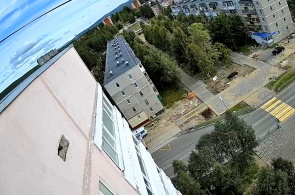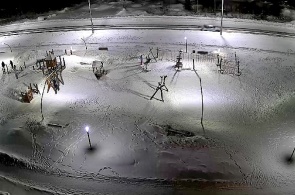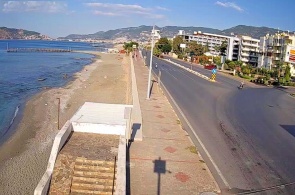The Polyarnye Zori webcam in real time shows a view of the intersection of Stroiteley - Lomonosov streets.
Roads, green spaces and part of a residential building with a multi-colored facade fall into the lens.The city of Polyarnye Zori, whose webcams are available on the site in real time, is located in the Murmansk region.
It is located beyond the Arctic Circle, but at the same time there is no such phenomenon as the polar night. Although the shortest day lasts only 21 minutes and happens once in December.One of the interesting objects of the Kola Peninsula is the Lapland Biosphere Reserve. It is interesting not only for its unique flora and fauna. In addition, on its territory there are two museums dedicated to the creators of this protected area. One is the house-museum of Herman Kreps. He was the first head of the reserve. His house was built in 1930 on the banks of the Chunozero near the first cordon and bathhouse. In the 1970s, it was transferred to the Chunozero estate and a museum was organized. The life of this researcher was short, but bright. He devoted almost all his years to the study of the Kola Peninsula. The exposition contains archival materials, manuscripts, photographs. The first geobotanical map of the reserve, which Kreps and his colleagues developed in the 1920s, is considered a unique exhibit. Sami clothes and shoes are also presented here.
The second object is the apartment-museum of Oleg Semenov-Tyan-Shansky in Polyarnye Zori.
Live webcams make it possible to immerse yourself in the atmosphere of the northern town.
The room is also located on the territory of the Chunozero estate. Here you can find out more about the work of the scientist who has devoted 60 years to the study of Lapland's nature. The greatest value lies in the manuscripts and personal belongings of the researcher. Also unique is the actograph - a device for recording the process of incubation of eggs by birds. Semenov-Tyan-Shansky assembled it himself.You should also visit the Saami exposition "In the Land of the Flying Stone". It is dedicated to the life of the indigenous population of the Kola Peninsula. Few people communicated with the Sami, but Herman Kreps, on the contrary, established contact with them so that he could study this area better. So, in 1923, he made an ethnographic expedition, and the indigenous population of the Kola Peninsula helped him a lot in this, because. they knew the territory and thanks to the deer they could move through deep snow. The first director of the reserve developed warm relations with many Saami. The exposition allows you to better learn the history of this region and, of course, immerse yourself in the life and life of the Sami.
Webcams Polyarnye Zori are broadcasting live from the city streets.
More details
Webcam in Polyarnye Zori with a view of the pedestrian crossing across Lomonosov Street. Nearby are apartment buildings, public transport stops, and other objects of urban infrastructure. The broadcast is in real time.
Polyarnye Zori, Russia
30.08.23
The Polar Dawns webcam broadcasts live a view of the pedestrian crossing located on the street. Builders. The lens hits the road and residential buildings.
Polyarnye Zori, Russia
27.09.22
Live webcams Polyarnye Zori allow you to see a modern stadium located on the territory of gymnasium No. 1. This is a diverse sports facility that is designed for football, basketball, volleyball, as well as athletics physical activities.
Polyarnye Zori, Russia
24.09.22
Webcams Polyarnye Zori online show a view of the playground, located between residential buildings on the street. Belova. The lens captures the sleeping area of the city, which allows you to appreciate the architecture of the Arctic town.
Polyarnye Zori, Russia
22.09.22
The Polyarnye Zori webcam online allows you to view the sports ground located near school No. 3. Live, you can watch what is happening on the street, as well as the prevailing weather conditions.
Polyarnye Zori, Russia
19.09.22
The Polar Dawns webcam broadcasts a view of the street. Lomonosov 13. The lens is installed on a residential building and directed towards the residential area of the settlement. The broadcast allows you to see the square and residential buildings.
Polyarnye Zori, Russia
16.09.22
Webcam Polyarnye Zori in real time shows a view of the street. Lomonosov 13. The second camera is installed on the other side of the residential building, therefore, mainly green spaces fall into its lens.
Polyarnye Zori, Russia
12.09.22
Live webcams broadcast the playground on the alley along Partizan Zapolyarya Street. The lens captures a modern public space. The elements of the playground are made of wood. You can watch what is happening in real time.
Polyarnye Zori, Russia
02.09.22
Live webcam Polyarnye Zori shows a view of the boulevard on the street. Partisan of the Arctic. The lens captures a residential complex under construction, a road and a small square near the house.
Polyarnye Zori, Russia
26.08.22
The Polyarnye Zori webcam broadcasts a live view of the gymnasium No. 1. The lens captures the building of a general education institution, a sports ground, and green spaces. You can also see houses.
Polyarnye Zori, Russia
20.08.22
Web camera with view of the monument to the MIG-19, a commemoration of war and post-war aviation history in 1978.
Polyarnye Zori, Russia
30.03.20
The intersection of Energetikov, Builders in polyarnyye Zori. Polyarnye Zori is a town in the Murmansk region, situated on the banks of the Niva river, 224 kilometers South from the regional center. The village square is 3.6 square kilometers.
Polyarnye Zori, Russia
30.03.20
Web camera in real time translates square Builders is located between buildings 12 and 13 at the Pushkin street in polyarnyye Zori, an open day to mark the 50th anniversary of the start of construction of the city.
Polyarnye Zori, Russia
21.03.20
Webcam in real time, broadcasts a children's Playground on the street the guerrilla of the polar region in the Polar Zori.
Polyarnye Zori, Russia
21.03.20
popular camerasshow all
Sultanahmet or Blue mosque is a work of art of Turkish-Islamic architecture. Its construction began in 1609, the construction work took seven years to a 19-year-old Sultan. The name of the mosque was, due to its interesting and unique finish.
Istanbul, Turkey
Stavanger, a town in the commune of Norway, located in the South-Western part of the country, on the Peninsula, rich in minerals. Tanager combines the influence of foreign organisations such as NATO and oil companies. The camera will shoot the harbour and the promenade of the city.
Stavanger, Norway
A webcam broadcasts the district of Tosmur - quiet location in the Eastern part of Alanya, located only five kilometres from the city centre. Its rural way of life and the beauty of untouched nature attract tourists.
Alanya, Turkey
Shark Island or in English of Shark island, located in the harbour city of Sydney, the suburb of Point Piper. The locals, the natives named the island Boambilly, which translated means Shark island. After all, this name is not casual, because it's mean and looks like a shark fin.
Sydney, Australia
The webcam is installed on site Alva. Tsaghkadzor ski resort town in Armenia. Tsaghkadzor is a beautiful mountainous area among deciduous forests, with a pleasant winter climate, and clean fresh air. The highest point is 1800 meters. The truss type is a classic, divided into three.
Tsakhkadzor, Armenia





















